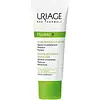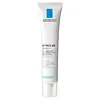What's inside
What's inside
 Key Ingredients
Key Ingredients

 Benefits
Benefits

 Concerns
Concerns

 Ingredients Side-by-side
Ingredients Side-by-side

Water
Skin ConditioningCetearyl Isononanoate
EmollientPolymethyl Methacrylate
Propylheptyl Caprylate
EmollientSqualane
EmollientGlycerin
HumectantDiglycerin
HumectantSteareth-2
EmulsifyingSteareth-21
CleansingButylene Glycol
HumectantCetyl Alcohol
EmollientDimethicone
EmollientPhenoxyethanol
PreservativeBrassica Campestris Sterols
EmollientGlyceryl Stearate
EmollientPEG-100 Stearate
Sodium Acrylate/Sodium Acryloyldimethyl Taurate Copolymer
Emulsion StabilisingAcrylates/C10-30 Alkyl Acrylate Crosspolymer
Emulsion StabilisingChlorphenesin
AntimicrobialParfum
MaskingIsohexadecane
EmollientPhytosphingosine
Skin ConditioningO-Cymen-5-Ol
AntimicrobialPolysorbate 80
EmulsifyingTocopheryl Acetate
AntioxidantTromethamine
BufferingAsiaticoside
AntioxidantOpuntia Ficus-Indica Stem Extract
Skin ConditioningRaspberry Seed Oil/Palm Oil Aminopropanediol Esters
Skin ConditioningBiosaccharide Gum-1
HumectantSorbitan Oleate
EmulsifyingDisodium Phosphate
BufferingWater, Cetearyl Isononanoate, Polymethyl Methacrylate, Propylheptyl Caprylate, Squalane, Glycerin, Diglycerin, Steareth-2, Steareth-21, Butylene Glycol, Cetyl Alcohol, Dimethicone, Phenoxyethanol, Brassica Campestris Sterols, Glyceryl Stearate, PEG-100 Stearate, Sodium Acrylate/Sodium Acryloyldimethyl Taurate Copolymer, Acrylates/C10-30 Alkyl Acrylate Crosspolymer, Chlorphenesin, Parfum, Isohexadecane, Phytosphingosine, O-Cymen-5-Ol, Polysorbate 80, Tocopheryl Acetate, Tromethamine, Asiaticoside, Opuntia Ficus-Indica Stem Extract, Raspberry Seed Oil/Palm Oil Aminopropanediol Esters, Biosaccharide Gum-1, Sorbitan Oleate, Disodium Phosphate
Water
Skin ConditioningGlycerin
HumectantDimethicone
EmollientIsocetyl Stearate
EmollientNiacinamide
SmoothingIsopropyl Lauroyl Sarcosinate
Skin ConditioningSilica
AbrasiveAmmonium Polyacryloyldimethyl Taurate
Emulsion StabilisingMethyl Methacrylate Crosspolymer
Potassium Cetyl Phosphate
EmulsifyingSorbitan Oleate
EmulsifyingZinc PCA
HumectantGlyceryl Stearate Se
EmulsifyingIsohexadecane
EmollientSodium Hydroxide
BufferingMyristyl Myristate
Emollient2-Oleamido-1,3-Octadecanediol
Skin ConditioningAluminum Starch Octenylsuccinate
AbsorbentMannose
HumectantPoloxamer 338
EmulsifyingDisodium EDTA
Capryloyl Salicylic Acid
ExfoliatingCaprylyl Glycol
EmollientVitreoscilla Ferment
Skin ConditioningXanthan Gum
EmulsifyingPolysorbate 80
EmulsifyingAcrylamide/Sodium Acryloyldimethyltaurate Copolymer
Emulsion StabilisingSalicylic Acid
MaskingPiroctone Olamine
PreservativeParfum
MaskingWater, Glycerin, Dimethicone, Isocetyl Stearate, Niacinamide, Isopropyl Lauroyl Sarcosinate, Silica, Ammonium Polyacryloyldimethyl Taurate, Methyl Methacrylate Crosspolymer, Potassium Cetyl Phosphate, Sorbitan Oleate, Zinc PCA, Glyceryl Stearate Se, Isohexadecane, Sodium Hydroxide, Myristyl Myristate, 2-Oleamido-1,3-Octadecanediol, Aluminum Starch Octenylsuccinate, Mannose, Poloxamer 338, Disodium EDTA, Capryloyl Salicylic Acid, Caprylyl Glycol, Vitreoscilla Ferment, Xanthan Gum, Polysorbate 80, Acrylamide/Sodium Acryloyldimethyltaurate Copolymer, Salicylic Acid, Piroctone Olamine, Parfum
 Reviews
Reviews

Ingredients Explained
These ingredients are found in both products.
Ingredients higher up in an ingredient list are typically present in a larger amount.
Dimethicone is a type of synthetic silicone created from natural materials such as quartz.
What it does:
Dimethicone comes in different viscosities:
Depending on the viscosity, dimethicone has different properties.
Ingredients lists don't always show which type is used, so we recommend reaching out to the brand if you have questions about the viscosity.
This ingredient is unlikely to cause irritation because it does not get absorbed into skin. However, people with silicone allergies should be careful about using this ingredient.
Note: Dimethicone may contribute to pilling. This is because it is not oil or water soluble, so pilling may occur when layered with products. When mixed with heavy oils in a formula, the outcome is also quite greasy.
Learn more about DimethiconeGlycerin is already naturally found in your skin. It helps moisturize and protect your skin.
A study from 2016 found glycerin to be more effective as a humectant than AHAs and hyaluronic acid.
As a humectant, it helps the skin stay hydrated by pulling moisture to your skin. The low molecular weight of glycerin allows it to pull moisture into the deeper layers of your skin.
Hydrated skin improves your skin barrier; Your skin barrier helps protect against irritants and bacteria.
Glycerin has also been found to have antimicrobial and antiviral properties. Due to these properties, glycerin is often used in wound and burn treatments.
In cosmetics, glycerin is usually derived from plants such as soybean or palm. However, it can also be sourced from animals, such as tallow or animal fat.
This ingredient is organic, colorless, odorless, and non-toxic.
Glycerin is the name for this ingredient in American English. British English uses Glycerol/Glycerine.
Learn more about GlycerinIsohexadecane is added to enhance texture, emulsify, and to help cleanse. It is an isoparrafin. It is a component of petrolatum.
Due to its large size, Isohexadecane is not absorbed by the skin. Instead, it sits on top and acts as an emollient. Emollients help keep your skin soft and smooth by trapping moisture within.
Isohexadecane is often used in products designed to help oily skin. It is lightweight and non-greasy while helping to moisturize. When mixed with silicones, it gives a product a silky feel.
Learn more about IsohexadecaneParfum is a catch-all term for an ingredient or more that is used to give a scent to products.
Also called "fragrance", this ingredient can be a blend of hundreds of chemicals or plant oils. This means every product with "fragrance" or "parfum" in the ingredients list is a different mixture.
For instance, Habanolide is a proprietary trade name for a specific aroma chemical. When used as a fragrance ingredient in cosmetics, most aroma chemicals fall under the broad labeling category of “FRAGRANCE” or “PARFUM” according to EU and US regulations.
The term 'parfum' or 'fragrance' is not regulated in many countries. In many cases, it is up to the brand to define this term.
For instance, many brands choose to label themselves as "fragrance-free" because they are not using synthetic fragrances. However, their products may still contain ingredients such as essential oils that are considered a fragrance by INCI standards.
One example is Calendula flower extract. Calendula is an essential oil that still imparts a scent or 'fragrance'.
Depending on the blend, the ingredients in the mixture can cause allergies and sensitivities on the skin. Some ingredients that are known EU allergens include linalool and citronellol.
Parfum can also be used to mask or cover an unpleasant scent.
The bottom line is: not all fragrances/parfum/ingredients are created equally. If you are worried about fragrances, we recommend taking a closer look at an ingredient. And of course, we always recommend speaking with a professional.
Learn more about ParfumPolysorbate 80 is a surfactant and emulsifier. It is used to keep ingredients together, and prevent oils and waters from separating.
It is made from polyethoxylated sorbitan and oleic acid. This ingredient can be found in cosmetics, foods, and medicine. It is water-soluble.
Polysorbate 80 may not be fungal acne safe.
Learn more about Polysorbate 80Sorbitan Oleate is created from compounds in oleic acid and sorbitol.
It is used to stabilize a product by preventing ingredients from separating. Emulsifiers help keep ingredients together, such as oils and water.
According to a manufacturer, the ingredient Sorbitan Monooleate shares an INCI name with this one.
Sorbitan Oleate may not be fungal acne safe. It can also worsen oily skin.
Learn more about Sorbitan OleateWater. It's the most common cosmetic ingredient of all. You'll usually see it at the top of ingredient lists, meaning that it makes up the largest part of the product.
So why is it so popular? Water most often acts as a solvent - this means that it helps dissolve other ingredients into the formulation.
You'll also recognize water as that liquid we all need to stay alive. If you see this, drink a glass of water. Stay hydrated!
Learn more about Water